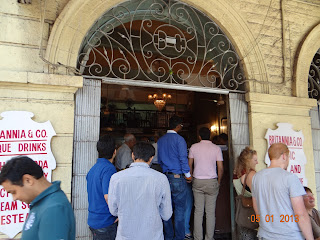My stint at Kapchorwa Hospital in 1970-71 was an experience of a different kind. Kapchorwa is situated in eastern Uganda, about 65 km. from Mbale, the nearest 'big' town. Kapchorwa sits at an altitude of 5,900 ft. above sea level and is akin to what we would call a hill station in India. The hills of Kapchorwa -- even today -- have a certain unspoilt beauty, and the air is crisp and cool. Kapchorwa is close to Mount Elgon that sits on the Uganda-Kenya border. Just outside the town after a sharp bend in the road, one can see the famous Sipi Falls, a majestic sight of three waterfalls that plunge down the mountains at the edge of Mount Elgon National Park. Kapchorwa is also home to the famous Bugisu tribe.
Back in those days, Kapchorwa was the district headquarters, even though it was a very small place. Our district hospital was also a small one -- with about 60 beds and a single doctor (me). This was small-town Africa in the early 1970s. There was no electricity in the town those days, but the hospital did have a generator (strictly for hospital use only). I was the only expatriate in the town. In contrast, the nearest town, Mbale, had plenty of Asians and other expatriates as well.
I was new to Uganda, and often felt lonely in Kapchorwa, where I was in the midst of complete strangers. I looked forward to my occasional visits to Mbale, where I would go for shopping for groceries and vegetables once a week.
Though occasionally I would have Indian visitors in Kapchorwa. They were welcome indeed. I looked forward to such visits -- it was a rare opportunity for me to interact with people from my own country, and may be converse in Hindi or Punjabi.
One fine day, a Punjabi friend of mine based in Kampala, came over to stay with me. He was establishing a saw mill in that region and hence, was a frequent visitor. On one of his visits, he had brought along a patient, a sardarji, working for him. That is how we became friends. After that, he would drop in whenever he came to Kapchorwa.
On one occasion which I remember very vividly for reasons best forgotten, he visited my house with his wife. I was delighted as usual to meet one of my kin. We chatted for a long time over cups of tea. After a while, my friend's wife used the toilet. Then they said goodbye and left.
Later I discovered, much to my disgust, a nasty piece of turd floating in the pot. I felt nauseated and all the happy feelings of spending a pleasant evening with fellow Indians evaporated. I flushed the toilet several times, but the lump stubbornly, decided to stay put. I was at my wit's end. I was trained to deal with the most complex of medical problems, but nothing like this. I also had no intention of leaving this unpleasant task to my houseboy, lest he wonder what my visitors were like.
I had tried every trick in the book -- and failed. Left with no option, I employed Plan B. I brought a big stick from the garden and got to work. Over the coming (and very unpleasant) 15 minutes, I broke the lump into several smaller pieces, struggled to keep myself from vomiting and after multiple flushes, I got rid of the damn thing.
I have many pleasant memories of Kapchorwa -- but this one is an ink blot.













